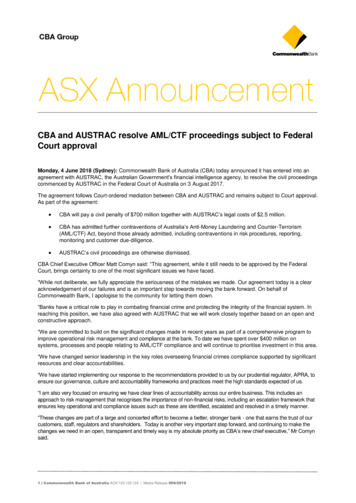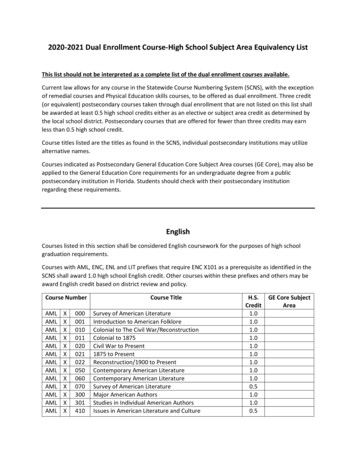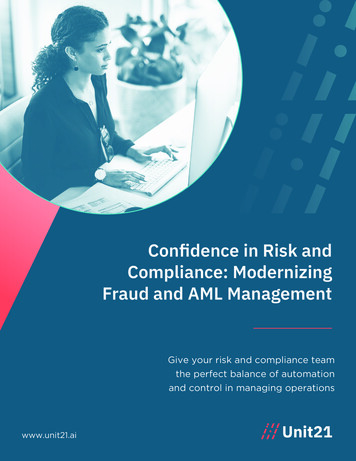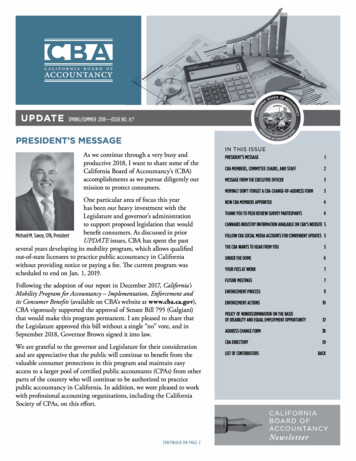
Transcription
CBA and AUSTRAC resolve AML/CTF proceedings subject to FederalCourt approvalMonday, 4 June 2018 (Sydney): Commonwealth Bank of Australia (CBA) today announced it has entered into anagreement with AUSTRAC, the Australian Government’s financial intelligence agency, to resolve the civil proceedingscommenced by AUSTRAC in the Federal Court of Australia on 3 August 2017.The agreement follows Court-ordered mediation between CBA and AUSTRAC and remains subject to Court approval.As part of the agreement: CBA will pay a civil penalty of 700 million together with AUSTRAC’s legal costs of 2.5 million. CBA has admitted further contraventions of Australia’s Anti-Money Laundering and Counter-Terrorism(AML/CTF) Act, beyond those already admitted, including contraventions in risk procedures, reporting,monitoring and customer due-diligence. AUSTRAC’s civil proceedings are otherwise dismissed.CBA Chief Executive Officer Matt Comyn said: “This agreement, while it still needs to be approved by the FederalCourt, brings certainty to one of the most significant issues we have faced.“While not deliberate, we fully appreciate the seriousness of the mistakes we made. Our agreement today is a clearacknowledgement of our failures and is an important step towards moving the bank forward. On behalf ofCommonwealth Bank, I apologise to the community for letting them down.“Banks have a critical role to play in combating financial crime and protecting the integrity of the financial system. Inreaching this position, we have also agreed with AUSTRAC that we will work closely together based on an open andconstructive approach.“We are committed to build on the significant changes made in recent years as part of a comprehensive program toimprove operational risk management and compliance at the bank. To date we have spent over 400 million onsystems, processes and people relating to AML/CTF compliance and will continue to prioritise investment in this area.“We have changed senior leadership in the key roles overseeing financial crimes compliance supported by significantresources and clear accountabilities.“We have started implementing our response to the recommendations provided to us by our prudential regulator, APRA, toensure our governance, culture and accountability frameworks and practices meet the high standards expected of us.“I am also very focused on ensuring we have clear lines of accountability across our entire business. This includes anapproach to risk management that recognises the importance of non-financial risks, including an escalation framework thatensures key operational and compliance issues such as these are identified, escalated and resolved in a timely manner.“These changes are part of a large and concerted effort to become a better, stronger bank - one that earns the trust of ourcustomers, staff, regulators and shareholders. Today is another very important step forward, and continuing to make thechanges we need in an open, transparent and timely way is my absolute priority as CBA’s new chief executive,” Mr Comynsaid.1 Commonwealth Bank of Australia ACN 123 123 124 Media Release 096/2018
CBA provided for an estimated penalty of 375 million in the half year ending 31 December 2017 at which time thebank noted the proceedings were complex and ongoing, and the ultimate penalty determined by the Court may be higher orlower than the amount provided for. CBA will recognise a 700 million provision in its financial statements for the fullyear ending 30 June 2018 which will be announced on 8 August.BackgroundThe settlement with AUSTRAC includes a Statement of Agreed Facts and Admissions. A copy of the Statement isattached to this announcement and is available on CBA’s website. In summary, as part of the agreement CBA hasadmitted to: Late filing of 53,506 Threshold Transaction Reports for cash deposits through Intelligent Deposit Machines(IDMs).Inadequate adherence to risk assessment requirements for IDMs on 14 occasions.Transaction monitoring did not operate as intended in respect of a number of accounts between October2012 and October 2015.149 Suspicious Matter Reports were filed late or were not filed as required.Ongoing customer due-diligence requirements were breached in respect of 80 customers.We appreciate the key role we play in supporting law enforcement to fight financial crime. Our contribution includes: During the period of the claim, we submitted more than 44,000 Suspicious Matter Reports, including 264SMRs in relation to the syndicates and individuals referred to in AUSTRAC’s claim.We submitted more than 19 million reports to AUSTRAC (including SMRs, TTRs and international fundtransfer instructions) during the period covered by the AUSTRAC claim up to the end of 2017. We submittedover 4 million of these reports to AUSTRAC in 2017 alone.We responded to approximately 20,000 law enforcement requests for assistance in 2017.CBA has made significant progress in strengthening its policies, processes and systems relating to its obligationsunder the AML/CTF Act through our Program of Action. This is a continuing process of improvement and has alreadyincluded: Boosting AML/CTF capability and reporting by hiring additional financial crime operations, compliance andrisk professionals with more than 300 professionals dedicated to financial crimes operations, compliance andrisk across the group.Strengthening Know Your Customer processes with the establishment in 2016 of a specialist hub providingconsistent and high-quality on-boarding of customers, at a cost of more than 85 million.Launching an upgraded financial crime technology platform used to monitor accounts and transactions forsuspicious activity.Adding new controls such as using enhanced digital electronic customer verification processes tosupplement face-to-face identification to reduce the risk of document fraud.Introducing an account based daily limit of 10,000 for cash deposits using IDMs, the first Australian bank todo so.For media inquiries contact:Danny JohnMedia Relations02 9118 6919media@cba.com.auFor investor inquiries contact:Melanie KirkInvestor Relations02 9118 7113CBAInvestorRelations@cba.com.au2 Commonwealth Bank of Australia ACN 123 123 124 Media Release 096/2018
NSD1305 of 2017Federal Court of AustraliaDistrict Registry: New South WalesDivision: GeneralCHIEF EXECUTIVE OFFICER OF THE AUSTRALIANTRANSACTION REPORTS AND ANALYSIS CENTREApplicantCOMMONWEALTH BANK OF AUSTRALIAACN 123 123 124RespondentSTATEMENT OF AGREED FACTS AND ADMISSIONSAINTRODUCTION1This Statement of Agreed Facts and Admissions (SAFA) is made for the purposes ofs 191 of the Evidence Act 1995 (Cth) (Evidence Act) jointly by the Applicant (theChief Executive Officer (CEO) of the Australian Transaction Reports and AnalysisCentre (AUSTRAC)), and the Respondent, Commonwealth Bank of Australia (CBA).2The SAFA relates to Proceedings NSD1305 of 2017 commenced by the CEO ofAUSTRAC against CBA on 3 August 2017 (Proceedings). By the Proceedings, theCEO of AUSTRAC has sought declarations that CBA contravened particularprovisions of the Anti-Money Laundering and Counter-Terrorism Financing Act 2006(Cth) (AML/CTF Act), and orders that it pay pecuniary penalties to theCommonwealth.3This document identifies the facts relevant to the contraventions admitted by CBA forthe purpose of the Proceedings. The facts agreed to, and the admissions made, areagreed to and made solely for the purpose of the Proceedings and do not constituteany admission outside of the Proceedings.4For the purposes of the Proceedings only, CBA admits that it contravened ss 36(1),41(2)(a), 43(2) and 82(1) of the AML/CTF Act in particular respects as set out inSection D of this SAFA.5The parties have reached agreement as to the terms of relief to be sought from theCourt to resolve the Proceedings. The parties acknowledge that, under s 175 of theAML/CTF Act, it is ultimately for the Court to determine whether CBA contravened a71922307
2civil penalty provision and the quantum of any pecuniary penalties and other relief thatshould be ordered.6The parties respectfully request that the Court make orders in the form set out in theaccompanying draft orders on the basis of the specific admissions in this SAFA.BPARTIES AND BACKGROUNDB.1AUSTRAC7The AUSTRAC CEO is appointed pursuant to s 211 of the AML/CTF Act. She ischarged with enforcing compliance with the AML/CTF Act and subordinate legislation,including the Anti-Money Laundering and Counter-Terrorism Financing RulesInstrument 2007 (No.1) (AML/CTF Rules) and has brought the Proceedings in thatcapacity.B.2CBA8CBA is a company incorporated in Australia. It is and was at all material times areporting entity within the meaning of s 5 of the AML/CTF Act and a provider ofdesignated services to customers within the meaning of s 6 of the AML/CTF Act.9At all material times, CBA has been an Authorised Deposit-Taking Institution (ADI),being a corporation which is authorised under the Banking Act 1959 (Cth) (BankingAct) to take deposits from customers, and has been licensed to carry on bankingbusiness in Australia under the Banking Act.10CBA is a leading provider of financial services, including retail, business andinstitutional banking and wealth management products and services. It is used by asmany as 1 in 3 Australians as their main financial institution.11CBA reported a Net Profit After Tax for the full year ending 30 June 2017 of1approximately 9,928 million. Of this, approximately 75% was returned toshareholders through dividends with the balance reinvested.122CBA maintains approximately 1,350 branches, servicing approximately 16.6 million3customers. CBA employs approximately 51,800 eholders/financial-information/results.html (accessed 16/10/2017).2CBA Annual Report 2017, page 5.3CBA Annual Report 2017, page 13.4CBA Annual Report 2017, page 13.71922307
313Reflecting its scale, size of customer base and geographic spread of operations, at allmaterial times CBA has operated complex computer and management systems andcontrols. CBA processes over 16 million transactions per day.B.3Background to CBA’s AML/CTF operations14Section 81 of the AML/CTF Act stipulates that a reporting entity must not commenceto provide a designated service to a customer if the reporting entity has not adopted,and does not maintain, an anti-money laundering and counter-terrorism financing(AML/CTF) program, which includes a “Part A” and a “Part B”.15Section 85(2) of the AML/CTF Act requires Part A of an AML/CTF program to:(a)have the primary purpose of identifying, mitigating and managing the riskthat the reporting entity may reasonably face that its provision of designatedservices might involve or facilitate money laundering or terrorism financing(ML/TF risk);(b)have regard to certain matters described at Part 9.1 of the AML/CTF Rules,including the type of ML/TF risk that might be reasonably faced by thereporting entity in determining and putting in place appropriate risk-basedsystems and controls; and(c)otherwise comply with the AML/CTF Rules, including by having a transactionmonitoring program and an enhanced customer due diligence (ECDD)program that have regard to certain matters described at Chapter 15 of theAML/CTF Rules.16At all material times CBA has had in place:(a)an AML/CTF function directed to the purpose of enabling CBA to complywith its obligations under the AML/CTF Act;(b)a joint AML/CTF program which included both a Part A and a Part B (CBA’sProgram), which had been adopted by CBA; and(c)designated management positions and personnel with direct responsibilityfor carrying out, and having oversight of, CBA’s AML/CTF function.17Part A of CBA’s Program was maintained and updated over time, and relevantlycomprised the following versions:(a)version 5.0 operated for the period from 28 October 2010 to 25 June 2014;(b)version 5.5 operated for the period from 26 June 2014 to 31 December2015;(c)71922307version 6.0 operated for the period from 1 January 2016 to 14 June 2016;
418(d)version 7.0 operated for the period from 15 June 2016 to 5 June 2017; and(e)version 8.0 operated for the period from 6 June 2017 to date.At all material times, Part A of CBA’s Program included an ongoing customer duediligence (OCDD) program (OCDD Program), which included risk-based systems andcontrols to monitor the provision by CBA of designated services to its customers forthe purpose of identifying, mitigating and managing its ML/TF risk.19The OCDD Program relevantly contained:(a)a transaction monitoring program (Transaction Monitoring Program),including:(i)a Financial Crime Platform (FCP) operated by CBA that generatedautomated transaction monitoring alerts (Automated TM Alerts).Automated TM Alerts were triggered according to CBA’s ruleparameters within the FCP, which ran a system of rules overtransactions in order to detect customer activity that was potentiallyunusual or suspicious;(ii)a system for CBA employees who identified potentially suspiciouscustomer activity, such as during the course of customerinteractions or periodic review of customer transaction data, toraise manual alerts (Manual Alerts), generally by completing aSuspect Transaction Report (STR);(iii)a platform for receiving and reviewing both Automated TM Alertsand Manual Alerts and filing suspicious matter reports (SMRs),being the Pegasus Financial Crime Case Management System(Pegasus);(b)a system for complying with CBA’s suspicious matter reporting obligations;and(c)an enhanced customer due diligence (ECDD) program (ECDD Program),including risk-based systems and controls directed to undertaking measuresappropriate to the circumstances in cases where one or more of thecircumstances in r 15.9 of the AML/CTF Rules arises.20Underpinning CBA’s Program, at all material times, CBA had in place a number offurther documents including Group Standards, Standard Operating Procedures, UserGuides and Reference Guides, which were maintained by CBA and updated from timeto time. These documents provided further specificity of the requirements, processes,systems and controls for CBA’s Program, including in respect of the OCDD Programand CBA’s approach to ML/TF risk.71922307
521In support of the OCDD Program, at all material times CBA employed a team ofpersonnel who were responsible for reviewing and investigating Automated TM Alertsand Manual Alerts, considering and actioning SMRs and undertaking ECDD asrequired (AML Operations team). Responsibilities within the AML Operations teamwere further divided into groups that included a Transaction Monitoring team and aCustomer Risk team. During the relevant period, within these groups:(a)Analysts in the Transaction Monitoring team were responsible for the initialreview and investigation of Automated TM Alerts and Manual Alerts, relatedcustomer due diligence and escalation of potentially suspicious matters toSenior Analysts within the same team;(b)Senior Analysts in the Transaction Monitoring team were responsible forconsidering escalated matters, forming suspicions and submitting SMRs tothe AUSTRAC CEO where appropriate, and performing quality assurance onthe work undertaken by Analysts;(c)Analysts in the Customer Risk team were responsible for the initial reviewand investigation of High Risk Customer (HRC) alerts, consideringcustomers who had been subject to SMRs and designating customers withHRC status, undertaking further customer due diligence in respect of HRCcustomers and customers who had been subject to SMRs and PEPs, andpreparing HRC reports recommending to the relevant business unit whetherto terminate a business relationship with a customer; and(d)Senior Analysts in the Customer Risk team were responsible for reviewingand approving HRC reports and other matters escalated by Analysts,escalating HRC reports to relevant business units once approved andperforming a second level review and quality assurance on the workundertaken by Analysts.CFACTS RELEVANT TO LIABILITYC.1Risk Assessments22By section 82(1) of the AML/CTF Act, CBA was obliged to comply with Part A ofCBA’s Program.23As required by the AML/CTF Act and AML/CTF Rules, at all material times Part A ofCBA’s Program (and documents underpinning this, including a Group Standard onRisk Identification and Assessment Methodology) required that CBA identify, mitigateand manage ML/TF risk by undertaking ML/TF risk assessments, including in respectof new methods of designated service delivery and new or developing technologiesused for the provision of a designated service prior to adopting them.71922307
624CBA’s Program, under Part A and the applicable Group Standard, required it to:(a)assess the inherent ML/TF risk posed by each new method of designatedservice delivery and new or developing technology prior to adoption;(b)review ML/TF risk assessments where there are significant instances ofmoney laundering using CBA’s products or services;(c)carry out periodic reviews of risk attributes and methodologies; and(d)ensure any material ML/TF risks identified were to be subject to systems andcontrols to manage them.25Risk assessments are a central component of a reporting entity’s compliance with theobligation to mitigate and manage ML/TF risk.26In May 2012, CBA introduced a new channel for providing designated services in theform of an Intelligent Deposit Machine (IDM). IDMs were introduced as part of aproject to refresh CBA’s Automated Teller Machine (ATM) fleet, starting with 5 IDMs.The IDM was, and is, a type of ATM which has the functionality to accept cash andcheque deposits into CBA accounts. Funds could be deposited using a CBA brandedcard or a card of any other financial institution (OFI). Funds can only be deposited tothe account of a CBA customer. In contrast to an ordinary or older ATM, any cashdeposited through an IDM is automatically counted by the machine and is instantlycredited to the nominated beneficiary CBA account. Those funds are immediatelyavailable for transfer, including for international transfer. In November 2017, a dailylimit was applied to cash deposits made to a CBA customer’s personal account whenthe cash was deposited using a CBA branded card. In April 2018, daily limits wereimplemented on the amount of cash that could be deposited into a CBA customer’spersonal or business account via an IDM.27The ML/TF risks of providing designated services through IDMs were high andobvious at all relevant times because cash could be deposited anonymously at anytime at hundreds of locations and transferred immediately, either domestically orinternationally, without any limit being imposed.28Prior to the introduction of IDMs, CBA considered certain AML/CTF matters, includingidentifying that threshold transactions might occur through IDMs and designingsystems to notify those transactions to AUSTRAC through threshold transactionreports (TTRs). At all times from the launch of IDMs, CBA applied its TransactionMonitoring Program to transactions occurring through IDMs. However, contrary to therequirements of CBA’s Program, CBA did not undertake an ML/TF risk assessmentspecific to IDMs prior to them being introduced.29The ML/TF risks of IDMs changed significantly throughout the period on and from May2012 when IDMs were first rolled out, as cash deposits into IDMs grew. In May 201271922307
7when the first 5 IDMs were first rolled out, cash deposits for that month totalled 868,825. By May 2017, at which time there were 805 IDMs, cash deposits for thatmonth were about 1.7 billion.30In 2014, CBA submitted SMRs to AUSTRAC relating to suspicions that moneylaundering was occurring through its IDMs. However, CBA did not at that timeundertake an ML/TF risk assessment of its IDMs and no new and appropriate riskbased controls were introduced to mitigate and manage the high ML/TF risks of IDMs.31By around July 2015, CBA had evidence that criminal syndicates were launderingseveral millions of dollars through its IDMs. CBA identified these significant instancesof money laundering through its own transaction monitoring and its own intelligenceand analysis, and was interacting with law enforcement regarding this activity,including with serious organised crime units of the Australian Federal Police (AFP).CBA later also interacted with New South Wales Police and Western Australian Policeregarding this activity.32In July 2015, CBA undertook an assessment of the inherent ML/TF risk of IDMs andassessed the IDMs to have a high inherent ML/TF risk. However, this assessment didnot follow the procedures set out in CBA’s Program and no new and appropriate riskbased controls were introduced to mitigate and manage the high ML/TF risks of IDMs.33On 18 December 2015, AUSTRAC provided a number of banks, including CBA, with aconfidential Methodologies Brief regarding ATM Deposits (the Methodologies Brief).In the Methodologies Brief, AUSTRAC identified possible indicators to assist industryto identify potential money laundering through ATMs (with the reference to ATMsbeing understood to include reference to IDMs). The Methodologies Brief recordedthat ATMs presented money laundering syndicates with the opportunity to depositlarge amounts of cash into accounts without imposing a daily cash deposit limit. Thislack of daily deposit limits, coupled with the ability to deposit cash anonymously, wassaid to present a ‘significant vulnerability’.34However, CBA did not at that time undertake an ML/TF risk assessment of its IDMsand no new and appropriate risk-based controls were introduced to mitigate andmanage the high ML/TF risks of IDMs. CBA did not act at that time to introduce dailylimits for cash deposits through IDMs to mitigate or manage the identified risk. CBAcontinued to rely on detective controls in the form of its Transaction MonitoringProgram, but acknowledges that these controls were not appropriately risk-based.35In July 2016, CBA undertook a further assessment of the inherent ML/TF risk forIDMs. CBA again assessed the IDMs to have a high inherent ML/TF risk, butconcluded that the residual risk of the IDMs were low, taking into account applicationof CBA’s Transaction Monitoring Program. The risk assessment noted that SMRswere being submitted in respect of transactions conducted through IDMs and so were71922307
8successfully identifying suspicious transactions. However, this assessment did notfollow the procedures set out in the CBA’s Program and no new and appropriate riskbased controls were introduced to mitigate and manage the high ML/TF risks of IDMs.36CBA undertook a further assessment of the inherent ML/TF risk for IDMs in October2017, after the commencement of these proceedings. CBA decided to impose dailylimits to cash deposits through IDMs. In that risk assessment, CBA recorded itsdecision to introduce daily limits for cash deposits made using personal CBA brandedcards, business CBA branded cards and OFI cards. This was to be done in stages(due to time needed to effect the change in systems). In November 2017, CBAimposed daily limits on cash deposits through IDMs in the form of a 20,000 limit oncash deposits made to personal CBA accounts using a CBA branded card. No dailylimits were introduced for cash deposits into CBA accounts using OFI cards. No limitswere imposed on the number of CBA branded cards that could be used to depositcash daily into CBA accounts. No daily limits were introduced for deposits, using aCBA branded card, into CBA business accounts. There were no daily limits on theamount of cash that could be deposited into a CBA account.37In April 2018, CBA undertook a further assessment of the inherent ML/TF risk forIDMs. CBA decided to impose a 10,000 limit on cash deposits through IDMs made toCBA personal and business accounts, subject to accounts of certain businesscustomers and institutional banking customers having a higher limit. On 12 April 2018,CBA implemented those account-based daily limits.38It was not until CBA introduced daily limits on cash deposits through IDMscommencing in November 2017 and completed by 12 April 2018 that CBA adoptedsufficient appropriate risk-based controls to mitigate and manage the ML/TF riskposed by IDMs.39As a consequence of the matters set out in paragraphs 28 to 38 above, CBAcontravened s 82(1) of the AML/CTF Act on 14 occasions by failing to comply withprocedures in its Part A Program by failing to:(a)undertake an assessment of the inherent ML/TF risk in respect of IDMs priorto the introduction of IDMs in or around May 2012;(b)introduce sufficient appropriate risk-based controls to mitigate and managethe ML/TF risks posed by IDMs in or around May 2012;(c)undertake a periodic assessment of the inherent ML/TF risk in respect ofIDMs in early 2014;(d)introduce sufficient appropriate risk-based controls to mitigate and managethe ML/TF risks posed by IDMs by introducing daily limits in early 2014,following the periodic assessment;71922307
9(e)undertake an assessment of the inherent ML/TF risk in respect of IDMs inmid to late 2014;(f)introduce sufficient appropriate risk-based controls to mitigate and managethe ML/TF risks posed by IDMs by introducing daily limits in mid to late 2014;(g)undertake an assessment of the inherent ML/TF risk in respect of the IDMsthat complied with CBA’s Program in July 2015;(h)introduce sufficient appropriate risk-based controls to mitigate and managethe ML/TF risks posed by IDMs by introducing daily limits in July 2015;(i)undertake an assessment of the inherent ML/TF risk in respect of the IDMsin December 2015;(j)introduce sufficient appropriate risk-based controls to mitigate and managethe ML/TF risks posed by IDMs by introducing daily limits in December 2015;(k)undertake a periodic assessment of the inherent ML/TF risk in respect ofIDMs that complied with CBA’s Program in mid-2016;(l)introduce sufficient appropriate risk-based controls to mitigate and managethe ML/TF risks posed by IDMs by introducing daily limits in mid-2016,following the periodic assessment;(m)undertake an assessment of the inherent ML/TF risk in respect of the IDMsthat complied with CBA’s Program in 2017 at a time prior to October 2017;and(n)introduce sufficient appropriate risk-based controls to mitigate and managethese ML/TF risks by introducing daily limits in 2017 at a time prior toNovember 2017.C.2Threshold Transaction Reporting to AUSTRAC40By s 43(2) of the AML/CTF Act, CBA was at all material times obliged to submit a TTRto the AUSTRAC CEO within 10 business days after the day on which a thresholdtransaction took place.41Between November 2012 and September 2015, CBA failed to submit TTRs in respectof 53,506 threshold transactions to the AUSTRAC CEO within 10 business days afterthe day on which the transaction took place.42The 53,506 TTRs relate to certain cash deposits which occurred through IDMs.Between May 2012 and October 2012, CBA had in place an automated process toidentify threshold transactions through IDMs and report TTRs to the AUSTRAC CEO(the TTR process). The TTR process identified transactions by transaction codes and71922307
10automatically generated TTRs in respect of threshold transactions by reference tothose transaction codes.43When IDMs were launched, two transaction codes were used to identify the types ofdeposits involving cash that could be made through IDMs, being transaction codes5022 and 4013. CBA’s system for TTR reporting was programmed to identify cashtransactions of 10,000 or more deposited via an IDM by undertaking an automatedsearch of system data for transactions using these transaction codes. Where theamount of cash deposited (or the cash component where it was a mixed deposit ofcash and cheque) was 10,000 or more, the system automatically generated a TTRfor submission to AUSTRAC.44In June 2012, an issue was identified regarding an error message which appeared inNetbank, CBA’s electronic banking site for its customers, in respect of cash-onlydeposits made at IDMs. In or around November 2012, to address that error messageappearing in Netbank, a third transaction code was introduced for certain cashdeposits through IDMs, being transaction code 5000. However, at that time the TTRprocess was inadvertently not updated and configured to automatically search fortransactions with the transaction code 5000 (in addition to the 5022 and 4013transaction codes) for the purposes of TTR reporting to AUSTRAC. As a result, cashdeposits through IDMs identified by transaction code 5000 did not automaticallygenerate TTRs from 5 November 2012 to 1 September 2015. Each of the 53,506TTRs was a cash deposit through an IDM which was identified by reference totransaction code 5000.45On 11 August 2015, AUSTRAC contacted CBA regarding two threshold transactionsmade through IDMs that were referred to in an SMR submitted by CBA to theAUSTRAC CEO on 7 August 2015, in circumstances where AUSTRAC could not findtwo corresponding TTRs being given by CBA. In investigating this inquiry, CBAidentified that TTRs were potentially not being reported automatically in the case ofthreshold transactions involving certain cash deposits through IDMs.46As described further at paragraph 70 below, CBA immediately took steps toinvestigate and address this issue, in the course of which it identified the53,506 threshold transactions in respect of which TTRs had not been submitted.47CBA ultimately submitted 2 of the TTRs to the AUSTRAC CEO late on 24 August2015 and the remaining 53,504 TTRs late on 24 September 2015.48As a consequence of the matters set out in paragraphs 41 to 47 above, CBAcontravened s 43(2) of the AML/CTF Act by failing to give 53,506 TTRs to theAUSTRAC CEO within the timeframe stipulated by s 43(2) of the AML/CTF Act.71922307
11C.3Transaction Monitoring Program49By section 82(1) of the AML/CTF Act, CBA was obliged to comply with Part A ofCBA’s Program.50At all relevant times, Part A of CBA’s Program provided that certain CBA products andservi
7 The AUSTRAC CEO is appointed pursuant to s 211 of the AML/CTF Act. She is charged with enforcing compliance with the AML/CTF Act and subordinate legislation, including the Anti-Money Laundering and Counter-Terrorism Financing Rules Instrument 2007 (No.1) (AML/CTF Rules) and has brought the Proceedings in that capacity. B.2 CBA










